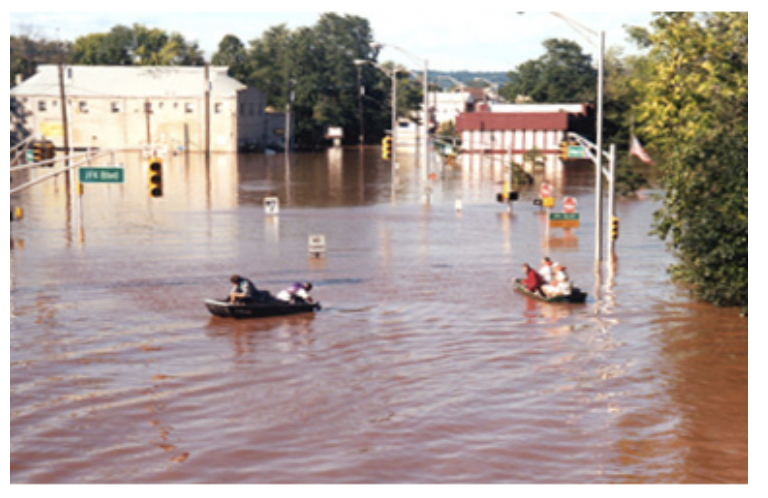Emergency Water Supply and Storage
Existing CommercialWhat is Emergency Water Supply and Storage?
New Jersey receives ample rainfall, and the state’s geology supports the storage of large quantities of groundwater and surface water.[1] However, water conservation and planning for water scarcity when water is plentiful can reduce the risk and the costs associated with increasing population growth, aging water infrastructure, and climate change impacts such as droughts on future water quality and availability. An increase in extreme weather events, such as major hurricanes, thunderstorms, ice storms, and flooding in New Jersey has highlighted the importance of having access to clean and safe water to meet drinking, sanitation and hygiene needs during and after natural disasters, extended power outages, and other emergencies. For example, flooding can overwhelm municipal water and wastewater treatment plants and storm-related power outages can impact plant operations. Flood waters can contaminate local water supplies and private wells with raw sewage and stormwater runoff containing chemicals, debris, and other contaminants that can cause serious illness.[2] While backup generators at municipal water and wastewater treatment plants can prevent power outages and elevating equipment can protect plant operations, individual building owners and operators can also take steps to safeguard water for emergencies.

Figure 1 – Flooding (Source: NJ DEP Flood Control)
Strategies to safeguard water at the building level include designating back-up power for water pumps, providing on-site water storage, and designing redundant water supply and treatment systems that utilize captured rainwater or recycled wastewater as the primary or backup water supply (see Rain Barrels and Cisterns, and On-site Alternative Water Reuse).
How to Provide for Emergency Water Supply and Storage
Planning for access to potable water during a power outage or storm-related event, starts with water conservation, and can include reusing water on-site, such as harvested rainwater or recycled greywater for storage and later use during emergencies to cover operations such as toilet flushing, mechanical equipment, and irrigation (see Water-Efficient Landscaping, Indoor Water Conservation, On-site Alternative Water Reuse).
The specifics depend on whether or not the building utilizes the municipal water system. During a water emergency, a building on municipal water may still have access to clean potable water due to the municipal water and treatment plant’s backup water storage or backup power system.[3] In this situation, planning for emergency water supply and storage requires providing backup power generation to operate water pumps and to distribute water throughout a building (see Energy Storage and Back-Up Power Generation).
Buildings with deep-well pumps that do not rely on the municipal water supply can utilize energy storage and back-power generation, or hand pumps to power the deep-well pump. Gravity-fed water from an on-site spring or cistern part of a rainwater harvesting system, which includes adequate water storage can provide a redundant or backup water supply to complement public or deep-well water resources. Where there is no option for on-site water replenishment, look to provide emergency water storage that can gravity-feed water to the building, such as rooftop water tanks or water storage with pumps powered by stored energy or off-grid generators.
Example
Stony Brook-Millstone Watershed Association Center
Rainwater collected from the building’s rooftop supplies water for flushing toilets, reducing municipal potable water, stormwater runoff, and energy used to pump and treat water.
Benefits
The benefits of planning for emergency water supply and storage become most apparent during an emergency or disaster. Proper preparations can reduce business closures and avoid health and safety hazards associated with water emergencies. Planning for access to potable water during emergencies can also benefit overall water conservation efforts during normal operations, as alternative solutions and reuse scenarios are considered to utilize and manage water on a site.
Costs
The rising cost over the last decade of water and wastewater services can make minor investments in water conservation strategies and back-up technologies cost-effective based on the savings alone from reduced water bills.[4] Factoring in savings from reduced energy bills further reduces payback periods. As the cost of water storage and backup power generation technologies decline and power outages and water emergencies become more common, the resiliency benefits of reduced business closures, health and safety hazards, and inconvenience from schedule disruptions, can offset the incremental costs. [5]
Resiliency
Providing for emergency water supply and storage enhances resiliency by utilizing redundant and local water supplies and reducing impacts from droughts and other instances of water scarcity. Ensuring access to potable water during emergencies decreases the reliance and stress on the entire municipal water infrastructure including groundwater pumping, and water and wastewater treatment and distribution, reducing the likelihood of system overload and failure.[6]
[1] New Jersey Department of Environmental Protection, 2017, New Jersey Water Supply Plan 2017-2022: 484p, http://www.nj.gov/dep/watersupply/wsp.html (accessed Oct 25, 2018).
[2] Center for Disease Control and Prevention. 2018. Healthy Water – Water-Related Emergencies and Outbreaks. https://www.cdc.gov/healthywater/ (accessed Nov 6, 2018).
[3] Wilson, Alex. 2015. LEED Pilot Credits on Resilient Design Adopted! http://www.resilientdesign.org/leed-pilot-credits-on-resilient-design-adopted/ (accessed Nov 6, 2018).
[4] Joseph Bourg. 2016. Water Conservation. Whole Building Design Guide – A Program of the National Institute of Building Science. https://www.wbdg.org/resources/water-conservation (accessed Oct 26, 2018).
[5] DOE. “Smart Grid Investments Improve Grid Reliability, Resilience, and Storm Responses.” https://www.smartgrid.gov/files/B2-Master-File-with-edits_120114.pdf (accessed May 1, 2018).
[6] Joseph Bourg. 2016. Water Conservation. Whole Building Design Guide – A Program of the National Institute of Building Science. https://www.wbdg.org/resources/water-conservation (accessed Oct 26, 2018).
